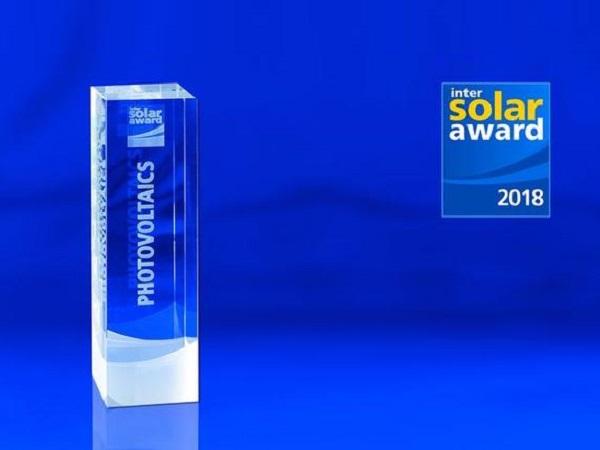
Date: 14 May 2018
From solar modules and inverters to substructures: The finalists of the Intersolar AWARD 2018 have put forward efficient, digital and cost-saving solutions, making them worthy contenders for the prestigious prize which honors pioneering technologies and services for the solar industry. The winners will be announced at Intersolar Europe, the world’s leading exhibition for the solar industry, at The smarter E Forum in hall B2, booth B2.570 on June 20, 2018.
The Intersolar AWARD ceremony has established itself as the celebratory end to the first day of the exhibition. For over ten years, the award winners have reflected the developments in the modern energy supply and motivated the industry to play an active part in shaping the energy future with constantly new, groundbreaking innovations.
The sector benefits from this – along with the winners – as the AWARD attracts international attention from clients, partners and the trade press. To be eligible for the Intersolar AWARD, applicants must be participating in at least one of this year’s Intersolar, ees, Power2Drive or EM-Power exhibitions around the world. Partner companies of the exhibitors may also submit their innovations.
EFFICIENT, SUSTAINABLE, CONTRIBUTING TO GRID STABILITY – EFFECTIVE SOLUTIONS ARE THE CURRENT TREND
In 2018, the spotlight is on solutions which exploit a product’s characteristics to achieve the best possible results. Solar module manufacturers have been able to consistently increase efficiency, with levels currently above 20%, and to extend the service life of modules to over 25 years.
This is achieved with high-performance cells or rear-side contacts. Furthermore, stable, thinner solar glasses are making PV modules lighter and simplifying the manufacture of bifacial modules. The surfaces of these glasses boast increasingly low reflectance, reducing glare even in challenging sunlight conditions.
And improved materials, such as an innovative, cost-effective encapsulation material – a polyolefin elastomer film – could replace current standards, in this case EVA film.
In the field of inverters for large-scale plants, decentralization concepts are moving into the spotlight. As a result, new grid management functions such as the ability to perform black starts, stand-alone grid formation, and active and reactive power control as well as frequency control are improving grid integration.
Digitalization is also opening up new opportunities –apps and cloud solutions are simplifying installation and assembly, smart assistance systems are taking over routine tasks, and grid structures such as wireless mesh networks are supporting system operation. And in the field of substructures, east-west systems are being constructed which are increasingly space-saving and simple to install.
THE FINALISTS
- ABB (Italy): ABB presents the PVS-175-TL string inverter for large-scale PV plants with 12 MPP trackers. It is highly efficient and has an enormous power density. Other noteworthy aspects are its ability to operate at 1500 V, the integrated data logging and communication standards, the installation app, diverse grid integration features and the connection to ABB’s cloud system.
- Ecoprogetti Srl (Italy): The LED solar simulator Ecosun Bifacial, offering an excellent measurement accuracy (AAA), was developed to measure the I/V characteristics of the front and rear side of bifacial PV modules at the same time. Different irradiation intensities can be selected for the rear side, ensuring that the testing is flexible and realistic.
- Gujarat Borosil Ltd (India): The new 2-millimeter-thick, fully tempered solar glass with an anti-reflection coating is a replacement for the standard 3.2 mm glass. The new glass is lighter and enables high transmission rates. The manufacturing process uses air cushion technology to prevent stripes, defective areas or discoloration and guarantees high production quality.
- Hanwha Q CELLS GmbH (Germany): Designed with round wire cell contacts and six busbars (front contacts), the half-cut cell module Q.PEAK DUO-G5 achieves a module efficiency of 19.9% with cost-effective standard p-type cells. The innovative technology Q.ANTUM DUO halves the current passing through each cell, stabilizing them and increasing their shade tolerance.
- Huawei Technologies Co., Ltd. (China): Thanks to its extremely high efficiency, the 60 kW Smart String Inverter (SUN2000-60KTL-M0) only requires passive ventilation. With features such as online monitoring of all connected strings including characteristic curve measurement, power line communications and a PID recovery mode, it has rightfully earned the product description “smart PV inverter.”
- Interfloat Corporation (Liechtenstein): Thanks to its special geometry and anti-reflective coating, the extremely low-reflection solar glass GMB DEFLECT for PV modules enables solar projects to be carried out in glare-sensitive areas such as traffic routes (rail, highways, intersections), flight paths or heavily built-up residential areas.
- Krinner Solar GmbH (Germany): The product CAS² optimizes the highly precise manufacture of support systems for free-standing PV installations. After the CAD-based system design has been drawn up, individual and optimized plans are prepared for every PV project and the installation robots are controlled with pinpoint accuracy.
- LG Electronics Inc. (South Korea): The LG NeON R module series features 6-inch monocrystalline high-efficiency cells, entirely rear contacted, with multi ribbon busbar technology. An extremely high module efficiency of over 21% along with a 25-year module performance warranty, high mechanical resilience, reverse current carrying capacity and impressive temperature behavior make the series worthy of recognition.
- Lumeta Solar (USA): The glassless module Lumeta Lynx for lightweight roofs is attached to the roof surface using a thermoplastic adhesive. Special cable ducts and junction boxes round off the concept. The use of monocrystalline PERC cells enables a module efficiency of 18.3% to be achieved.
- RenewSys India Pvt. Ltd. (India): The new encapsulation film CONSERV E 360 Polyolefin Elastomer Encapsulant is anticipated to replace the commonly used EVA film in the production of solar modules. The material is particularly remarkable for its high insulating ability, excellent protection against potential-induced degradation (PID), improved mechanical stability and low permeability to moisture.
© Solar Promotion GmbH
 600450
600450






















Add new comment